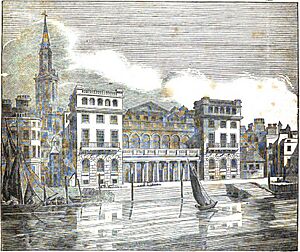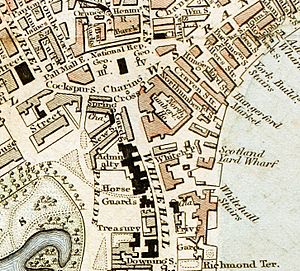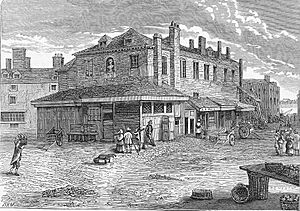Hungerford Market facts for kids
Hungerford Market was a busy market in London, located at Charing Cross on the Strand. It was a place where people could buy fresh produce like fruits and vegetables.
The market existed in two different buildings on the same spot. The first building was put up in 1682. The second, newer building opened in 1833. This new market was designed in an Italian style by Charles Fowler.
However, the new market didn't do very well. It was damaged by a fire in 1854. Later, in 1862, the market was sold to the South Eastern Railway. They tore it down to build Charing Cross railway station, which opened in 1864.
Contents
Where Was Hungerford Market?
The land where Hungerford Market stood became the property of the Hungerford family in 1425. This family came from Farleigh Hungerford Castle near Bath.
The land was once known as "Hungerford Inn." It stayed with the Hungerford family for many years. Eventually, it passed to Sir Edward Hungerford in the late 1600s.
The First Market Building
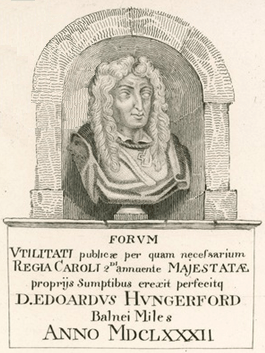
Sir Edward Hungerford (who died in 1711) got permission to hold a market on his land three days a week. The old Hungerford Inn building, which had been damaged by fire, was turned into shops with a covered area. This became the first market.
However, this market never really succeeded. Sir Edward sold parts of the land to others, including the famous architect Sir Christopher Wren. Even with new owners, the market didn't get much more trade.
Sir Edward Hungerford ended up losing his money and died without much wealth. In 1718, the market was sold to a royal gardener named Henry Wise. His family owned it until 1830. Then, a new group called the Hungerford Market Company bought it.
The New Market Building
Quick facts for kids Hungerford Market Company Act 1830 |
|
|---|---|
| Act of Parliament | |
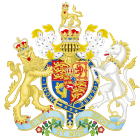
|
|
| Citation | 11 Geo. 4 & 1 Will. 4. c. lxx |
| Text of statute as originally enacted | |
| Hungerford Market Company Act 1836 | |
|---|---|
| Act of Parliament | |

|
|
| Long title | An Act to alter and enlarge the Powers of an Act passed in the Eleventh Year of the Reign of His late Majesty, for incorporating the Hungerford Market Company. |
| Citation | 6 & 7 Will. 4. c. lxviii |
| Dates | |
| Royal assent | 21 June 1836 |
| Other legislation | |
| Amends | Hungerford Market Company Act 1830 |
| Text of statute as originally enacted | |
By the early 1800s, the old market was falling apart. In 1830, a special law was passed to create a company to build a new market. This company bought the old market site and nearby houses.
All the old buildings were torn down. A brand new market was built between 1831 and 1833. It was designed by Charles Fowler, who also designed Covent Garden Market. The new buildings were mostly made of strong granite.
Market Layout and Features
The new market was a long strip of land, about 126 feet wide and 465 feet long, stretching towards the Strand. Near the river, there was a wharf about 200 feet long with steps leading down to the water.
The market had three main parts:
- Fish Market: The lower part of the market was for selling fish. It had an open area with two levels of covered walkways on each side. Since Old London Bridge had been replaced, fishing boats could now come further up the river. The company hoped to compete with Billingsgate Market by offering a closer place for people in the West End to buy fish. Later, a metal roof was added to protect the fish stalls. Two buildings near the river were used as taverns.
- Fruit and Vegetable Market: A set of steps led from the fish market to an upper level. Here was the Great Hall, a large building with a timber roof, where fruits and vegetables were sold.
- Butchers' Shops: North of the Great Hall was another open area with covered walkways and shops for butchers. A new street, Hungerford Street, led from here to the Strand.
Exciting Additions
In 1845, a suspension bridge was built by Isambard Kingdom Brunel. This bridge connected the market to Lambeth on the south side of the River Thames.
In 1851, a hall for lectures called Hungerford Hall was built next door. In the same year, a clever businessman named Carlo Gatti opened a stand at the market. He sold pastries and ice cream for just one penny, served in a shell. This might have been the first time ice cream was sold to the general public in London!
Why the Market Was Demolished
Hungerford Market found it hard to compete with bigger, more specialized markets like Billingsgate for fish and Covent Garden for produce.
The market was badly damaged when Hungerford Hall burned down in 1854. In 1862, it was sold to the South Eastern Railway. They tore down the market to build Charing Cross railway station, which opened on January 11, 1864.
Brunel's suspension bridge was replaced by the new Hungerford Railway Bridge. The chains from Brunel's old bridge were reused to finish building the famous Clifton Suspension Bridge in Bristol.
What Remains Today
The Hungerford family is still remembered in the name of the Hungerford Bridge. This bridge leads into Charing Cross from the south bank of the River Thames.



